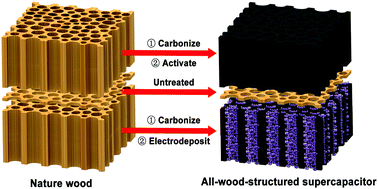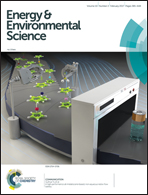All-wood, low tortuosity, aqueous, biodegradable supercapacitors with ultra-high capacitance†
Abstract
In energy storage devices, the critical demands for high energy/power density, low cost, long cycle lives and environmental friendliness have highlighted an urgent need for developing storage electrodes with low cost, large thickness, high mass loading, low tortuosity and high energy/power density. Here we demonstrate the design and construction of an all-wood-structured asymmetric supercapacitor (ASC) based on an activated wood carbon (AWC) anode, a wood membrane separator and a MnO2/wood carbon (MnO2@WC) cathode. The structural virtues of the all-wood-structured ASC device – desirable thickness (up to ∼1 mm), direct channels with low tortuosity, high electronic and ionic conductivity – enable ASC high areal mass loadings (up to 30 mg cm−2 for the anode and 75 mg cm−2 for the wood carbon/MnO2 composite cathode), a high energy density of 1.6 mW h cm−2 and a maximum power density of 24 W cm−2, representing the highest mass loading and areal energy/power densities among all reported MnO2-based supercapacitors. Moreover, all components in the all-wood-structured ASC are low-cost, environmentally friendly and biocompatible. With these unique features, the all-wood-structured ASC represents a promising energy storage device to realize high mass loading, high energy/power density, and biocompatibility for green and renewable energy storage.



 Please wait while we load your content...
Please wait while we load your content...